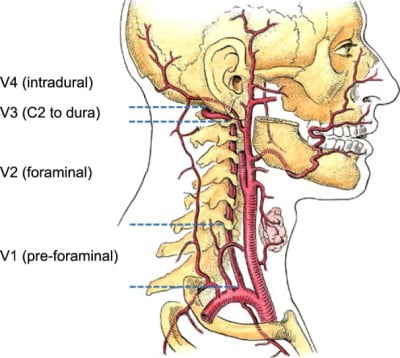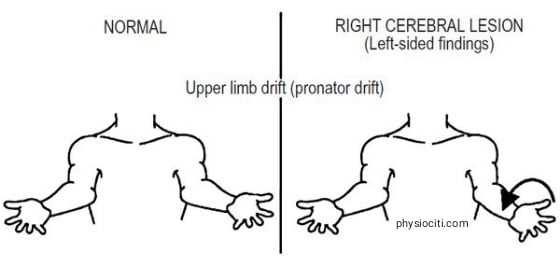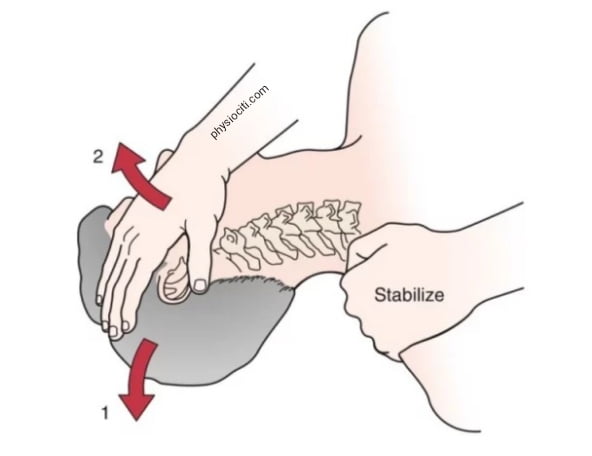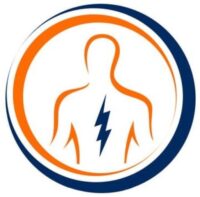Vertebrobasilar insufficiency is a condition in which there is poor blood flow to the posterior portion of the brain.
As a component of the vertebrobasilar system, the vertebral artery travels through the cervical vertebrae’s transverse processes, often beginning at C6 but sometimes reaching as high as C4. It supplies 20% of the blood supply to the brain (primarily the hindbrain) along with the internal carotid artery (80%). In its path, the vertebral artery lies close to the facet joints and vertebral body where it may be compressed by osteophyte formation or injury to the facet joints.
ICD-10 code for vertebrobasilar insufficiency: G45.0
The vertebral artery gets stressed maximally at four places:
- Where it enters the transverse process of C6
- Within the bony canals of the vertebral transverse processes
- Between C1 and C2
- Between C1 and the entry of the arteries into the skull

Risk factors:
- Atherosclerotic changes in the elderly
- Hypertension
- High cholesterol
- Hyperlipidemia
- Direct vessel trauma
- Infection
- Clotting disorders
- Diabetes
- Smoking
- Obesity
- Family history
Signs & Symptoms of Vertebrobasilar insufficiency:
- Dizziness
- Giddiness
- Drop attacks
- Loss of consciousness
- Stroke
- Diplopia (double vision)
- Blurred vision
- Visual hallucination
- Sweating
- Tinnitus (ringing in the ear)
- Vertigo
- Tremors and rigidity
- Numbness and tingling
- Photophobia (sensitivity to light)
- Quadriparesis (weakness in all four limbs)
- Nystagmus
- Ataxia (lack of voluntary muscles coordination)
Diagnostic tests for vertebrobasilar insufficiency:
We are going to discuss many vertebral artery tests, not all of them have to be performed. When doing more than one test, take a rest of 10 seconds between each test to ensure there are no symptoms remaining from the previous test.
Movements to the right tend to have more effect on the left vertebral artery, and movements to the left tend to have more effect on the right artery.
1. Barre’s Test for vertebrobasilar insufficiency
- For this test, the patient stands with the shoulder forward flexed to 90degrees. Elbows should remain straight and forearms in supination, palms up, and then close your eyes.
- The patient has to hold this position for 10 to 20 seconds.
- The test is considered positive if one arm slowly falls with simultaneous forearm pronation.
- The cause is thought to be diminished blood flow to the brainstem.

2. Hautant’s Test
This test has two parts. This test differentiates dizziness and vertigo caused by articular problems from that caused by vascular problems.
- The patient sits and forward flexes both arms to 90degrees, the same as the barre test. Then close your eyes. The examiner keeps an eye out for any shift in arm posture. If the arms move, the cause is non-vascular.
- The patient is then asked to rotate or extend and rotate the neck. This position is held with the eyes closed. If wavering of the arms occurs, the dysfunction is due to the vascular impairment of the brain. Maintain each position for 10-30 seconds.

3. Underburg’s Test
- For this test, the patient stands with the shoulder flexed to 90 degrees, elbows straight, and forearm supinated.
- The patient then closes the eyes and marches in place while holding the extended and rotated head to one side.
- The test is repeated with the head moved to the opposite side.
- This test is positive if there is a dropping of the arms, loss of balance, or pronation of the hands.
4. Vertebral Artery (Cervical quadrant) Test
- With the patient in the supine position, the examiner passively takes the patient’s head and neck into extension and side flexion.
- After this, the examiner rotates the patient’s neck to the same side and holds it for approximately 30 seconds.
- A positive test provokes referring symptoms if the problem is in the opposite artery.
- If dizziness or nystagmus occurs, it is an indication of vertebrobasilar insufficiency.
- To test the upper cervical spine, the examiner pokes the patient’s chin and follows with extension, side flexion, and rotation.

NOTE: Perform all the above tests with care and under the supervision of a physiotherapist.
Treatment:
Vertebrobasilar insufficiency can be treated by making lifestyle changes and by maintaining a healthy lifestyle:
- Control hypertension
- Quit smoking
- Reduce the amount of fat intake
- Maintain a healthy weight
- Medications to treat underlying causes like hypertension, diabetes, and cholesterol.
If the above treatment doesn’t help with your blood flow, then your medical health professional may suggest surgery. Surgery includes:
- Vertebral artery reconstruction: Procedure to fix the damaged arteries that carry blood to your brain.
- Coronary artery bypass surgery
- Coronary angioplasty and stent insertion
- Carotid endarterectomy
ALL THE BEST!


My brother suggested I might like this blog. He was totally right. This post actually made my day. You can not imagine simply how much time I had spent for this info! Thanks!